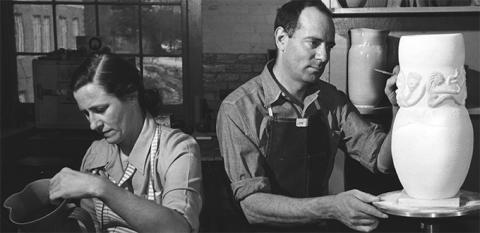
September 5 - December 19, 2003
Dale Valena, Museum Curator
The 1930s, a decade of equal parts despair and hope, inspired innovations like the League of New Hampshire Arts and Crafts, incorporated in 1932 to help build small NH craft industries and boost the local economies. That same year the League created a pottery program at UNH that was staffed by amateur teachers over the first several years. By 1940 David Campbell, president of the League of New Hampshire Arts and Crafts (now known as the League of New Hampshire Craftsmen), saw a need for a professional artist to elevate the program to a higher level. He attended a pottery conference in Black Mountain, NC and met a young couple named Ed and Mary Scheier. Campbell liked their work and within a year of their meeting offered them jobs at UNH, Ed as instructor and Mary as artist-in-residence.
The Scheiers worked at UNH from 1940 to 1960, during which time they constantly won awards in American and international competitions. They taught and inspired hundreds of students. Professional artists and potters - including those too young to have them as teachers - claim inspiration from the Scheiers' work. This exhibition explored their legacy as teachers and mentors.
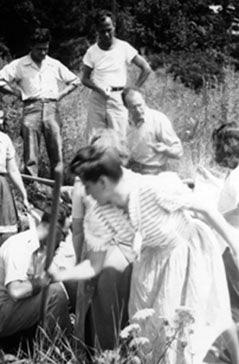
The Durham clay pits were located in the vicinity of the outdoor swimming pool.
Photo courtesy of the Currier Art Museum.
Digging Clay
"The first assignment for the new pottery term was to pile in the back of a UNH pickup truck and go out to the clay pits to get the semester's supply…Durham clay is quite remarkable, a fine-grained red earthenware with much of the working qualities of porcelain. Unlike porcelain, it has only about a 15 degree firing range, after which it melts rather quickly."
"At the end of my first semester, Mr. Scheier had told us for some time, the class would go to the clay pits behind the outdoor swimming pools and dig a new supply of clay. Mr. Scheier gleefully provided us with an array of funny-looking accessories. I was the smallest, he had me wear a pair of yellow slicker trousers with so suspenders that would have fit a man of 300 pounds, plus he had me carry a shovel with an eight-foot handle. He decreed the tallest person in the class, a lanky young man, should carry the smallest tool. He outfitted the others with similarly silly-looking gear, picks and shovels, etc. Several were given five gallon glass jars to carry, which we assumed were to be used to bring the clay we would dig back to the pottery studio.
"He marched this very peculiar looking group single file across campus to the clay pits that hot, sunny day, and we attracted quite a few stares as we labored under our loads. When we finally got to the clay pits, he announced that we were not actually going to dig clay! He had an abundant supply, but he wanted us to see what clay pits look like. And the picks, shovels, slickers? That was just to attract attention. The glass jars? 'To catch frogs!'"
"Some of the students occasionally worked for Ed making clay for the classes: Mixing in a large blunger that afterwards delivered it to a filter press… The standard rate for student help was .65 an hour, and the ceramic helpers were on some weird budget…Ed described it on pay slips as "controlled erosion" to get it past some bureaucratic hurdle."
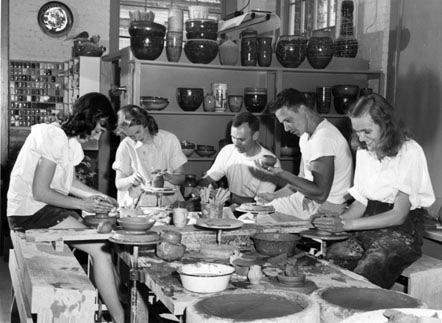
Ed Scheier (middle) with pottery students, 1950
Photo: Richard Merritt, ©UNH
In Class
"I luckily enrolled in the Scheier pottery class my sophomore year at UNH. Not only was I introduced to the art of pottery, but I had the opportunity to work with extremely talented and modest people."
"When it came time to teach us how to use the potter's wheel, Mr. Scheier stood observing us as we unsuccessfully tried to REASON how to center a lump of clay. "You musn't THINK about it, you must FEEL it," Mr. Scheier explained. That puzzled me a lot at the time, but it is probably one of the best lessons I've had."
"We all had our moments of frustration when something didn't turn out right. The student who sat next to me was making a set of dishes and was upset because she couldn't get the plates to come out the same size. Mr. Scheier smiled his little smile and told the story of the woman who had a baby and loved it, but when all her other children were born she threw them away because they didn't match the first."
A student commenting on her post-UNH years, "I taught a few pottery classes and took some instruction too. But no amount of involvement in potting elsewhere can compare to the times spent for four years in the Scheier pottery classes. There was just something very special about that wonderful couple, and their 'children'."
"When I think about the humor that pervaded Mr. Scheier's classroom, I think it was a way of quietly communicating…of recognizing one another as precious and unique individuals."
"There were small clay human figures, presumably made by Mr. Scheier, on the shelf where our pottery sat waiting to dry. One afternoon we stayed after class, fashioned a windowshade cord into a hangman's noose, and hanged one of the little people. Why did we do this? Were we breaking free of all authority? Were we proving we weren't nice people after all? I have no idea. But I do know that the next day when we came to class that poor little dead man was lying face up in a tiny clay coffin and I was both amused and sad."
"My three semesters of pottery with the Scheiers were some of the very best times of my life."
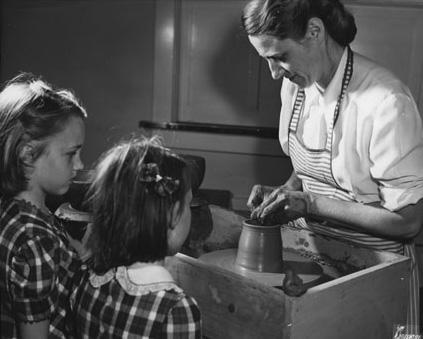
Mary Scheier demonstrating pottery techniques at the 14th Annual League of New Hampshire Crafts Fair, Franconia Notch Craft Center, 1946. The little girls observing Mary Scheier are Karen and Beth Haslerud, family friends of the Scheiers.
Mary Scheier at Work
"I luckily enrolled in the Scheier pottery class my sophomore year at UNH. Not only was I introduced to the art of pottery, but I had the opportunity to work with extremely talented and modest people."
"When it came time to teach us how to use the potter's wheel, Mr. Scheier stood observing us as we unsuccessfully tried to REASON how to center a lump of clay. "You musn't THINK about it, you must FEEL it," Mr. Scheier explained. That puzzled me a lot at the time, but it is probably one of the best lessons I've had."
"We all had our moments of frustration when something didn't turn out right. The student who sat next to me was making a set of dishes and was upset because she couldn't get the plates to come out the same size. Mr. Scheier smiled his little smile and told the story of the woman who had a baby and loved it, but when all her other children were born she threw them away because they didn't match the first."
A student commenting on her post-UNH years, "I taught a few pottery classes and took some instruction too. But no amount of involvement in potting elsewhere can compare to the times spent for four years in the Scheier pottery classes. There was just something very special about that wonderful couple, and their 'children'."
"When I think about the humor that pervaded Mr. Scheier's classroom, I think it was a way of quietly communicating…of recognizing one another as precious and unique individuals."
"There were small clay human figures, presumably made by Mr. Scheier, on the shelf where our pottery sat waiting to dry. One afternoon we stayed after class, fashioned a windowshade cord into a hangman's noose, and hanged one of the little people. Why did we do this? Were we breaking free of all authority? Were we proving we weren't nice people after all? I have no idea. But I do know that the next day when we came to class that poor little dead man was lying face up in a tiny clay coffin and I was both amused and sad."
"My three semesters of pottery with the Scheiers were some of the very best times of my life."
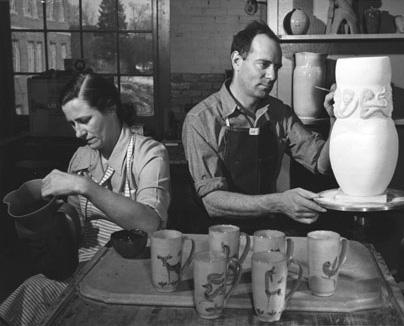
While Mary Scheier created the fine utilitarian ware for which she is so famous, Ed developed his unique motifs in large vessels, plates, and sculptures.
The Potboilers
In the 1940s to late 1950s most of the tableware was thrown by Mary and glazed by Ed. Mary refers to the tableware as 'the potboilers': "We had to do this looking toward getting out of teaching and giving all of our time to making pottery. We had to build up some security. So I made hundreds of beer mugs and hundreds of casseroles and creamers and sugars."
A student tells a story about asking Ed Scheier if she could leave a bag of groceries in the studio while she ran an errand on campus. When she got home and unpacked her groceries, her eggs were each covered in tiny drawings.
"One of my most wonderful memories of Mr. Scheier was his answer to a very personal question I conjured up the nerve to ask. As he and his wife appeared to be utterly happy and content and yet had no children I was a little curious and actually inquired one day after class as to why that might be. Can you imagine my nerve? His answer to me was, as he smiled and pointed to his pots "these are my children."…No amount of potting elsewhere can compare to the times spent for four years in the Scheier pottery classes. There was just something very special about that wonderful couple, and their 'children.'"
"The Scheiers kept a very disciplined schedule: studio from 8-10:00, Ed would teach from 10-12:00, then they would work after lunch until Ed's class from 2-4:00, maybe work some more, and then home."